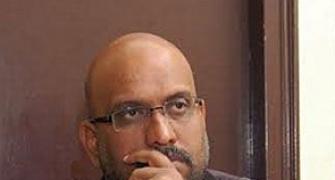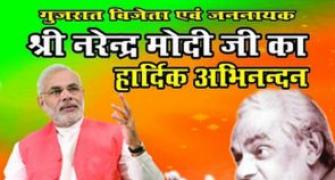Dr Kaushal Kishore Mishra, the prime accused in the assault on Somnath Bharti, says he never attacked the AAP leader. The professor then explains the polarisation politics of Varanasi to A Ganesh Nadar/Rediff.com
Dr Kaushal Kishore Mishra is head of the department of political science at the Banaras Hindu University. He is also the prime accused in the assault on Somnath Bharti, the controversial Aam Aadmi Party leader, in Varanasi on April 23 by a mob of alleged Bharatiya Janata Party activists.
Dr Mishra, left, says he did not attack Bharti, the former Delhi law minister, and that he was at the scene of the attack as a guest on a television show.
"(AAP chief) Arvind Kejriwal stayed in my uncle's home when he first came to Varanasi. He used it as an office, so we told him to leave. He blames me for that," says Dr Mishra.
"I don't know Bharti and he doesn't know me," says Dr Mishra. "There were 500 people there and I was a known face. Let me tell you what happened that day."
"Bharti said, 'Modi ke muh par jadu marenge (We will hit Modi with a broom)'. He was badly beaten up. There was an FIR registered against 100 unknown persons."
"Later, my name was added and I was arrested. I did not go there (to the venue) on my own. India TV had called me as an expert on politics."
The professor then explains the polarisation of politics in Varanasi.
"The break-up of the electorate is Muslims: 3 lakh (300,000); Brahmins: 3 lakh, Bhumihars: 1.5 lakh (150,000); Dalits: 1 lakh (100,000); Patels: 70,000; boatmen: 60,000, Gujaratis: 70,000, Yadavs: 1 lakh and the rest: 2 lakh (200,000)."
"There was never castiest polarisation in Banaras. It is always communal polarisation. It is a peculiar kind of polarisation. From 1952 to 1991 it was with Socialists like Ram Manohar Lohia and Raj Narain or the Congress."
"After the saffron mobilisation during the Ayodhya movement this became a BJP citadel," Professor Mishra adds.
"This is the first time that Varanasi is getting a chance to elect a prime minister designate. Narendra Modi started off on the right note by talking to the weavers. He explained to them that though they were the producers it was the Gujaratis who were selling it for them."
"The weavers are in the majority among Muslims, but the upper caste Muslims like the Qureshis and the Khans are against Modi."
"In 1889 Narendranath Dutta came here from Bengal, he studied and meditated here. From here he went to Chicago and came back as Swami Vivekananda. We made Narendranath into Vivekananda. In 2014 another Narendra has come here. We will make him prime minister."
"By making peace with Mukhtar Ansari (the imprisoned ganglord and runner-up in the 2009 Lok Sabha election)," Professor Mishra feels, "Congress candidate Ajay Rai has alienated the Bhumihars who would have voted for him en masse. Ansari is considered an enemy by the Bhumihars as he murdered many of them including Ajay Rai's brother."
"There will be around 60 percent voting and Modi will get the Brahmin vote. He will get the youth vote among the Dalits. The Patel leader (of the Apna Dal) Anupriya Patel has an alliance with the BJP, so he will get that vote too."
"He will also get a part of the Dalit vote and the Yadav vote. Just keep in mind that Varanasi's Yadavs do not like (Samajwadi Party leader) Mulayam Singh Yadav. Modi will get half the votes from the rest of the communities."
"It will be Modi first," the professor predicts, "Ajay Rai second and Arvind Kejriwal third."
Photograph: A Ganesh Nadar/Rediff.com








